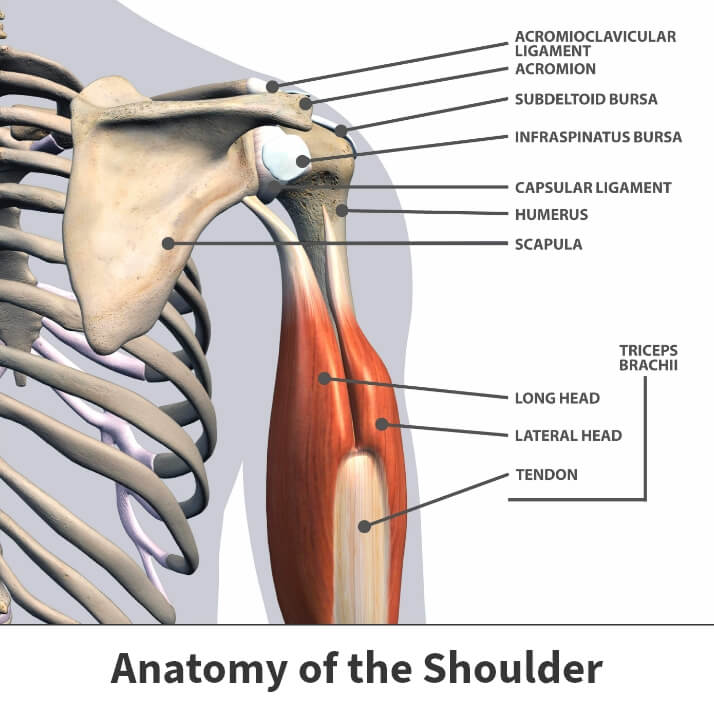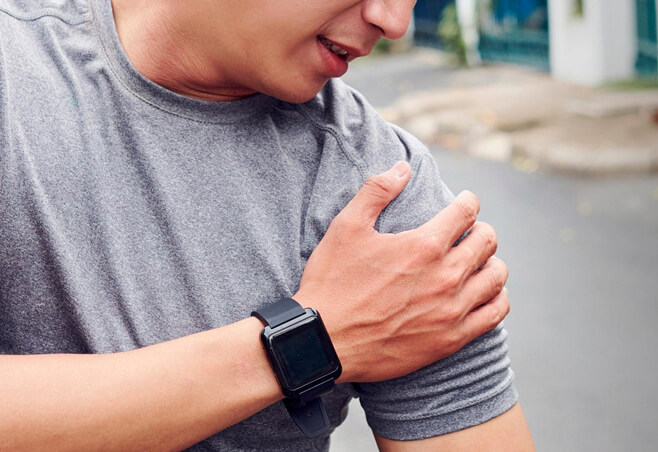A dislocated shoulder is when the upper arm bone falls out of the shoulder socket. There are several different types of shoulder dislocations. They are identified by the direction of which the upper arm bone dislocates and the severity of the injury. Regardless, they all result in pain and swelling and need to be treated immediately. Treatment for a dislocated shoulder consists of putting the upper arm bone back into the shoulder joint and rehabilitation exercises to restore flexibility and strength to the joint.
Anatomy

Your shoulder is made up of three bones; your upper arm bone (humerus), your shoulder blade (scapula), and your collarbone (clavicle).
The head of your upper arm bone fits into a rounded socket, known as the glenoid, in your shoulder blade. A combination of muscles and tendons, known as the rotator cuff, keep your arm bone centered in your shoulder socket. The rotator cuff covers the head of your upper arm bone and attaches it to your shoulder blade.
Within the shoulder joint, there are small, fluid-filled sacs known as bursae (or bursa). Their purpose is to provide a cushion between your joints, which helps reduce friction between the muscles and bones in the joint.
About
The shoulder joint is one of the largest and most complex joints in the body as it can turn in many directions. Unfortunately, the complexity of the joint makes it vulnerable to dislocation.
There are two types of dislocations; a partial dislocation and a complete dislocation. A partial dislocation, known formally as subluxation, means that the head of the upper arm bone is partially out of the socket. A complete dislocation means that the upper arm bone is completely out of the socket. Both partial and complete dislocations cause pain and unsteadiness in the shoulder.
The shoulder joint can dislocate either forward, downward, or backward. The most common type of shoulder dislocation is the forward version. This type of shoulder dislocation is known as an anterior instability and results in the upper arm bone moved forward and out of the shoulder socket. A common way for this type of dislocation to occur is during a throwing motion.

Symptoms
The symptoms of a dislocated shoulder include:
- Pain
- Deformity
- Muscle spasms
- Swelling
- Numbness caused by damaged nerves
- Weakness
- Bruising
- Possibly torn ligaments or tendons
Diagnosis
Your Florida Orthopaedic Institute physician will take a look at your overall medical history and current symptoms to help determine if you have a dislocated shoulder. Your physician may also order an X-ray to confirm that you have dislocated your shoulder and do not have any other injuries. If you dislocate your shoulder, the X-ray produces an image of your upper arm bone not correctly positioned in the shoulder socket. MRI (magnetic resonance imaging) and/or CT (computerized tomography) scans may be needed to better understand the injury.
Once your physician has done the examination and any necessary tests, they will determine which treatment plan is best for you.
Treatment
Dislocated shoulder injuries are typically treated nonsurgically. First, your physician will put your upper bone back in the socket. Rehabilitation, done slowly, helps restore strength and flexibility to the shoulder.
If you have reoccurring shoulder dislocations, your physician may look at surgery to help fix any damage these dislocations have caused and help prevent future dislocations.
Nonsurgical treatment
Your Florida Orthopaedic Institute physician will manually place the ball of the upper arm bone back into the joint socket. This resetting of the joint is known as a closed reduction. Any severe pain you may have had before the closed reduction will stop almost immediately afterward.
After the shoulder joint has been repositioned, your physician may immobilize your shoulder using a sling or a different device for several weeks. Also, they may recommend icing the shoulder three to four times a week to help reduce swelling.
Once the pain and swelling have gone down, your physician will prescribe rehabilitation exercises to strengthen the shoulder and regain flexibility. Rehabilitation can also help prevent the shoulder from being dislocated in the future. Typically, rehabilitation will begin with gentle muscle toning exercises, followed with weight training exercises once the joint begins to heal.
Surgical treatment
If shoulder dislocation becomes a recurring problem and therapy and bracing do not work, surgery may be needed to repair or tighten the torn or stretched ligaments that help hold the joint in place, particularly in young athletes. Recurring shoulder dislocations can result in some bone damage to the upper arm bone or the shoulder socket. If your physician finds some bone damage, they may recommend a bone transfer type of surgery.
Videos
Related specialties
- AC Joint Injuries
- Atraumatic Shoulder Instability
- Bankart Repair
- Bicep Tenodesis
- Broken Collarbone
- Bursitis of the Shoulder (Subacromial Bursitis)
- Calcific Tendinitis of the Shoulder
- Clavicle Fractures
- Fractures of the Shoulder Blade (Scapula)
- Glenoid Labrum Tear
- Impingement Syndrome of the Shoulder
- Little League Shoulder
- Reverse Total Shoulder Replacement
- Rheumatoid Arthritis (RA) of the Shoulder
- Rotator Cuff Tears
- Shoulder Arthritis
- Shoulder Arthroscopy
- Shoulder Injury: Pain in the Overhead Athlete
- Shoulder Replacement
- Shoulder Separations
- Shoulder Socket Fracture (Glenoid Fracture)
- SLAP Tears & Repairs
- Subacromial Decompression
- Trapezius Strain (Muscle Strain Of The Upper Back)
- Traumatic Shoulder Instability
